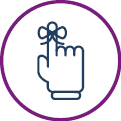Motivational Interviewing to Help Your Patients Seek Treatment

Motivational interviewing (MI) is a collaborative conversation style intended to strengthen someone’s motivation and commitment to change and willingness to accept treatment.1,2
- Patients recognize their autonomy in choosing their own path to recovery.
- Clinicians support patients to make meaningful changes to reach a mutually agreed upon goal.
- Clinicians validate their patients’ internal and external barriers for change and assist them in helping their patient overcome those barriers to pursue treatment.

MI involves a person-centered, non-confrontational approach in which the interviewer listens reflectively and demonstrates empathy to engage with the patient and develop rapport; help the patient to identify a goal for change (a “select behavior”); evoke and reinforce the patient’s internal motivation to change; and help the patient to develop a plan of action to achieve their goal.
This allows the patient to explore the positive and negative aspects of using substances and encourage them toward making a decision for positive change. For example, “People use substances for many different reasons. Please share with me what yours were both in the beginning and now.” or “Please share with me any concerns you have about your substance use.”
Reflect what you understood the patient to have said, building on what the patient has shared. Summarize after the patient has recounted a personal experience or when the conversation is nearing an end.
- Prompt: So, what I have heard you say is that on the one hand you have felt that substances have helped you with… But on the other hand, have not particularly appreciated how your substance use has… Where does this leave you?
For example, “On a scale of 1 to 10, how important is it for you to change [name the behavior] if you decided to?” When asking your follow up question, use a number lower than the patient’s answer to encourage them to reflect on how they are already considering change. Ask, “How are you at a [fill in the number on the scale] instead of a [choose a lower number on the scale]?” Using a higher number may discourage or prompt “sustain talk” (statements for why a patient is not changing). Whatever the response, use it as an opportunity to start a deeper conversation about the patient’s readiness to change.

- Tell them that recovery is possible and that paths to recovery look different for different people.
- Discuss the benefits of medication for a patient with an opioid use disorder.
- Use a clear and available “warm handoff” to transition the patient to ongoing treatment. Work with them to find placement in a program, coordinate care, and if needed and available, provide a transportation voucher and connect them to other social services that might be helpful.
- Follow up with patients after providing a referral to treatment. If they have not acted on the referral, discuss challenges or barriers that might be stopping them and ways to overcome them.
Provide additional information or resources for patients to learn more on their own, such as the Substance Abuse and Mental Health Services Administration (SAMHSA) National Helpline 1-800-662-4357 or the Decisions in Recovery handbook.
1 Miller, W. R., & Rollnick, S. (2012). Applications of motivational interviewing. Motivational interviewing: Helping people change (3rd ed.). New York: Guilford Press.
2 https://www.cdc.gov/opioids/providers/training/motivational-interviewing.html
3 https://store.samhsa.gov/sites/default/files/d7/priv/tip35_final_508_compliant_-_02252020_0.pdf
4 https://www.fda.gov/drugs/drug-safety-and-availability/fda-recommends-health-care-professionals-discuss-naloxone-all-patients-when-prescribing-opioid-pain
